If you’ve been following our little series of posts chock full of lovely Leslie Ragan art in advertisements for the Budd company, you may have noticed a few ads featuring Budd’s RDC – or Rail Diesel Car. Today’s post completes our collection of Ragan ads, and focuses on the RDC. The RDC’s were widely used here and around the world – Australia, Canada, Brazil, and even Saudi Arabia all had RDC’s operating at some point in time.
The versatile RDC was an all stainless steel, self propelled railcar that could be operated as a single unit, or multiple cars could be coupled into one longer train. While they operated on all sorts of runs, it was common to see them on lines with fewer passengers, and in commuter service where there was no electrification – like the Upper Harlem Line.
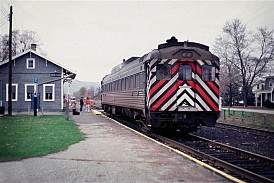 Â
 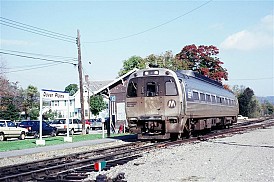
Budd-built cars operating on the Harlem Line – at left, an RDC at Dover Plains, at right an SPV-2000, also in Dover Plains. While the RDC was highly successful, the supposed successor SPV was hardly so – acquiring the less-than-flattering nickname “Seldom Propelled Vehicle.”
Here’s the last few ads with Ragan’s art, all advertising the RDC:
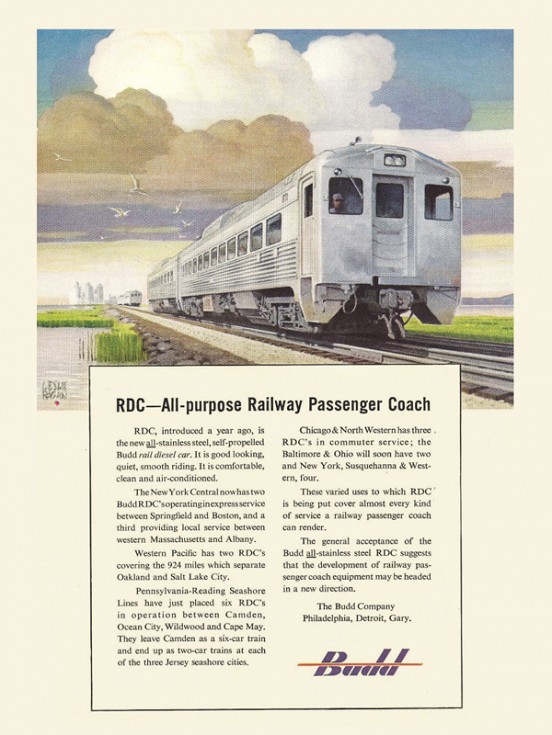 Â
 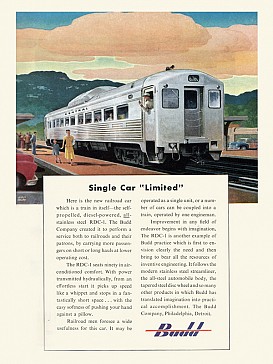 Â
 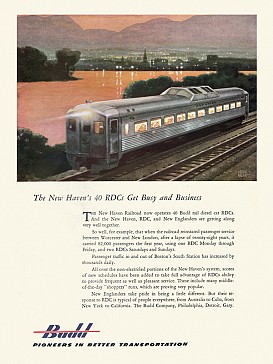 Â
 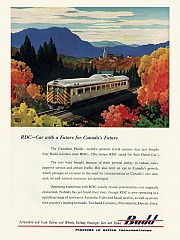 Â
 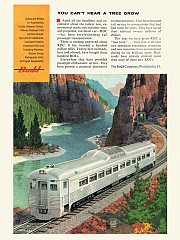 Â
 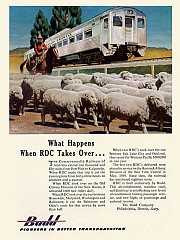
Ragan’s art successfully made the RDC look rather dreamy. Realistically, the RDC, with its stainless steel body, was somewhat attractive. By today’s standards, the inside does look a bit dated though. Here are a few Budd promotional photos of the RDC:
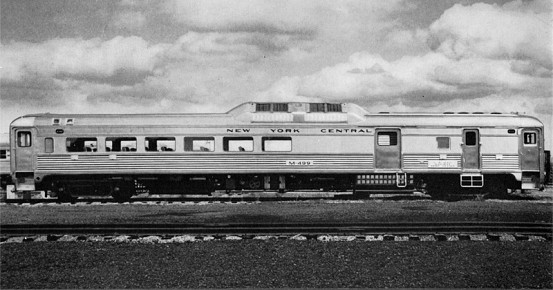 Â
 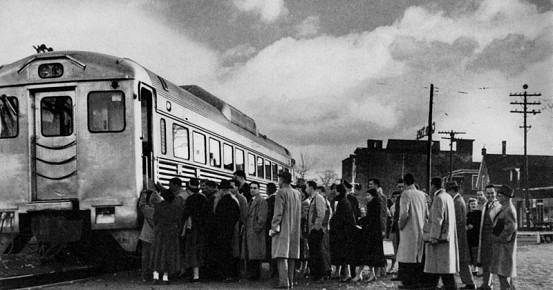
Top: A New York Central RDC-3. This model featured seats for 48 passengers, and room for baggage and mail. Bottom: Passengers board a New Haven RDC.
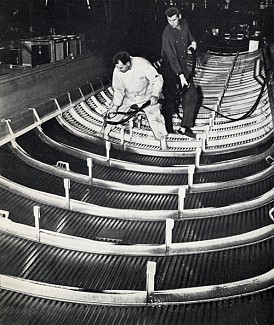 Â
 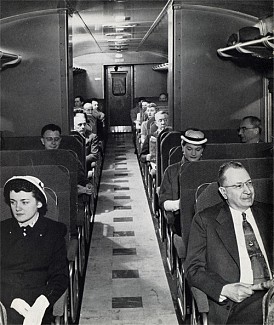
Left: Construction on the inside roof of an RDC. Right: An RDC in action.
The first RDC’s were offered in four different models, numbered 1 through 4. The RDC-1 was for passengers only, and seated 89. The RDC-2 seated 70 passengers, and had a 17 foot baggage compartment. The RDC-3 combined passenger seating with baggage and mail, it accommodated 48 passengers, a 17 foot baggage compartment, and a 15 foot mail apartment. The RDC-4 carried no passengers, and had a baggage compartment measuring 31 feet, and a mail apartment 30 feet long. Ever curious what the first four versions looked like? Here are the schematics, which were published by the Budd Company in a 1953 promotional booklet called “RDC Comes of Age.”


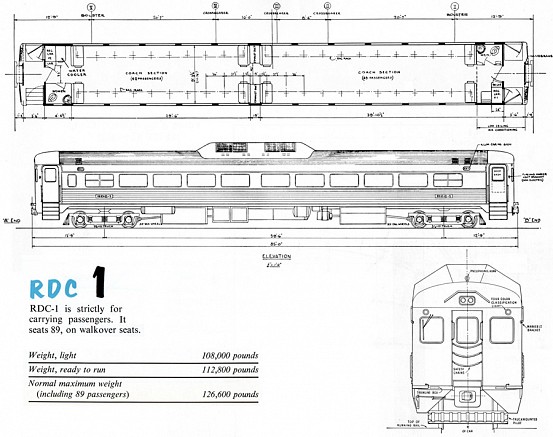
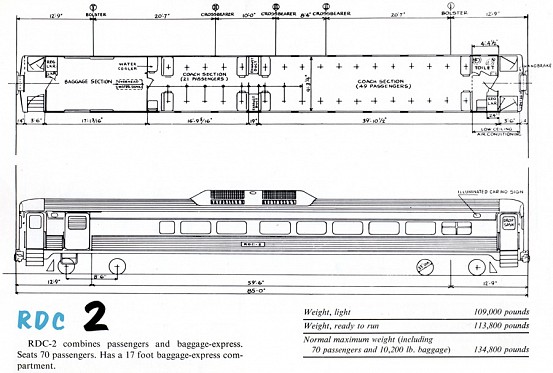
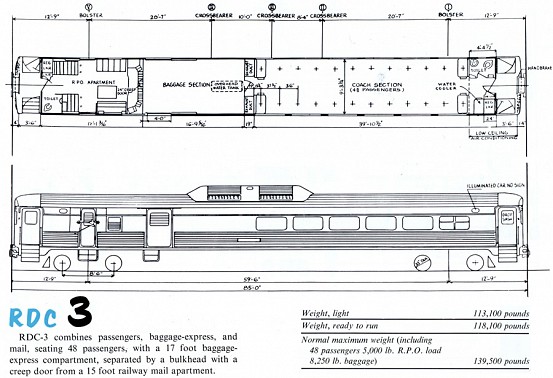
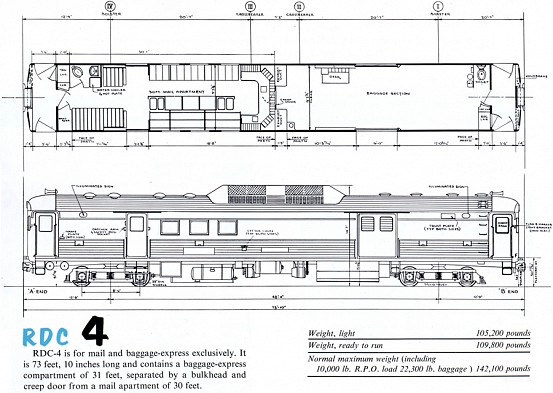
Nice! The Long Island Rail Road had an RDC-1 and an RDC-2 back in the day, and they tore the hell out of the things using them to “tow” mail and express cars on occasion, voiding the warranty with Budd. A problem with these cars was the lack of cab protection in a wreck, and I do recall one fatal grade crossing incident resulting in the death of an engineer.
There was the RDC-9 as well,basicly a “trailer” coach,with only 1 engine
to handle the heating/ AC/ lights,no cab controls as well, used by the B+M RR
in their Boston commuter service.
Believe DRM has their RDC up and running in the museum yard trackage.
Yes the RDC at Drm NH32 does make runs during the colder months of the operating season. She runs very nicely. Warm in the winter, and quite comfortable car to ride and operate.
The New Haven also had an RDC oddity. It was powered by diesel and third rail for entrance into GCT. Called the Roger Williams, it had a diesel loco type cab instead of a vestibule at each end of the train. I don’t think it had control cabs in the in-between cars. It did not survive long on the New York to Boston service and spent out it’s NHRR days as a commuter train in the Boston area.
Interesting stuff. I think the Wikipedia article on the Budd Company is worth a look. More info can be found here, including a great 1952 newsreel, “Clear Iron”, which features the RDC. Don’t miss it!
http://www.youtube.com/watch?&v=pDQeVUnZ0JI
sanford162/ I like all thing about trains being that I have work for the N.Y.C. M.T.A. for #30 years and love every day of it yes I do ! So to see old newsreels I just can not tell you how I feel . To see it ,due to air travel that is a by gone area of my time ..But you know some thing it is coming back the rails don’t you just love it I do full steam ahead no stops on my line!
The New Haven’s “Roger Williams” originally consisted of six RDC1s, two with cabs. I’m not sure it had NYC under-running third-rail pickups. I’ll have to check that out. In the later years, the restrictions of running Diesels into GCT were virtually ignored. Many NH FL-9s, having their 3d-rail shoes clipped off at some point (there were guards/trackside clippers to do just that, for west bounds at Woodlawn, in case they didn’t deploy properly) came in under full Diesel, and even idled on a storage track all day. An EP-5 would be dead-in-the-water, at that point.
The SPV-2000 was an apparent disaster. Some did go into Amtrak service, but not for long.
I rode the RDCs on NYC (“Beeliners”), CPR (“Dayliners”), and the CNR. Still love ’em! There are a few dozen for sale in Moncton, NB, if you are interested.
NYC RDC M-497 was the one fitted with two jet engines on the roof. It set some sort of a speed record out in Ohio. Very fast! I think those same jet engines were utilized in the NYC’s snow blowers (which are still in use), but dunno, fur sure.
Aren’t the two “Hot Rod” (or “Roger Williams”) Budd Cars with the cab unit noses also in preservation in Danbury?
One of the Chicago and North Western units, which made its way to Boston, is in my back yard at Union, where there is some talk of putting it into running order again.
Boston and Maine bought those single-engine middle units in order to stay in the warranty. The same management team, when it was wrecking the New Haven, had the idea of painting some of their lightweight passenger coaches silver, installing control cabling, and using them as middle cars between Budd Cars. The company got wind of the dodge, and alerted the railway that the warranty would not be honored if transmissions were torn up pulling the extra loads.
Funnily, Budd experimented with its own unpowered car, the Pioneer III, which became the basis of the electric multiple unit cars deployed in Philadelphia.
Some of our “Latter Day” Harlem trains, electric locomotive hauled, mated with RDCs (usually three RDCs), tacked on behind the train at NWP. They weren’t shut down and entered GCT on an upper-level loop track. Track #37 comes to mind. They rapidly re-loaded, or deadheaded back to NWP, were cut off, and continued up the Harlem for their next trip. Dunno how long that lasted.
I also remember the RDC’s being towed from NWP to GCT. I don’t ever remember them being towed behind an electric locomotive hauled train but they were usually towed behind MU’s. They were shut down just before entering the Park Ave tunnel and started up after leaving the Park Ave tunnel. The practice of towing them became a warranty issue and the practice was stopped. It lasted a fair while. I think it finally ended when the FL-9’s started coming across and the need for an engine change at NWP ended. As I recall, at that point the RDC’s ended up in Upper Harlem service.
I can’t remember much about Dover Plains but I was curious about the RDC picture posted above. Any idea on a time frame? I don’t recall a station building up there, only platforms.
Judging by the cars in the picture, I’d say that the SPV photo is from the late 80’s.
I confess! When I went to St. Lawrence U., in Canton, NY, I sometimes rode the “Beeliner”. One ran north from Utica, the other north from Syracuse. We did have the option of the “Canton Creeper”, loco hauled, with through a sleeper from Harmon, and south (east). The train was the preferred mode during a heavy North Country snow event. A bunch of us “students” were smoking in the rear vestibule, on a snowy day. Someone (not me!) got the bright idea that jumping up-and-down in the vestibule was cool. We got that RDC bobbing like a carousel horse or a boat going out of Jones’ Inlet. Lucky we didn’t derail it! The engineer had to stop and we were directed to take seats. End of silliness (for a while). Beer made me do it!
The Syracuse and Utica RDCs combined at Watertown and continued up the St. Lawrence Division to Massena.
I used to regularly ride to and from Crestwood to Harlem Valley-Wingdale in the summers of 1978 to 1981. The RDC was the mode of transportation north of Brewster. Two memories: 1) Smoking was still allowed on trains in those days and half the car was smoking, half non-smoking, which really meant that the whole car smelled like a smoker. 2) We once had to wait somewhere between Patterson and Harlem Valley-Wingdale for the cows to get off the tracks.
Lol, just figured I’d throw in that one evening on my commute I heard an engineer on the radio with the RTC saying that there were cows loose on the Harlem. It still happens, albeit very, very rarely!
In the Philadelphia area, the Reading Company used RDCs to provide service on the outer ends of non-electrified lines. This included Lansdale-Bethlehem, Fox Chase-Newtown, Norristown-Reading-Pottsville, and West Trenton NJ-Newark-NJ. All of these services were eliminated in the early 1980s and today SEPTA Regional Rail is all electric.
One Reading Co. run used a conventional diesel train set. This train was sold to the MTA and briefly used out of Grand Central Terminal to serve the upper Harlem Line before it was electrified. The train was still in its gaudy SEPTA colors.
I believe RDCs are still used in regular revenue train service in a few places.
Addendum: the NYC jet-powered RDC (-2, or -3) M-497 clocked 183.85 mph somewhere between Indiana and Ohio.
I seem to remember the North Harlem RDCs tacking on behind electric locomotive-powered “T” and “P” motors, and their coaches, at NWP. I don’t think they were shut down in the Park Avenue Tunnel. They would have lost all ‘hotel power’ (heat, A/C, lighting, etc.). Like I said, the ban on Diesel power in GCT (if there ever was one) was ignored. I rode many NH trains, behind FL-9s, that were Diesel all-the-way.
Hitting a herd of “Borden’s” Guernsey stock would have been expensive and messy, even though the cows didn’t have the right-of-way. ‘Elsie’, and ‘Elmer’, would have been pissed!
In the early 1980s the MTA having trouble with its diesel-electric fleet. Sometimes it was necessary to run trains under diesel power into Grand Central. The diesel fumes from the locomotives were everywhere when that was done.
The expansion of electrification to Brewster and acquisition of new electric trains helped the situation. Also, the FL9’s were sent out for a heavy overhaul which improved their performance and extended their service life.
That’s why GCT had all those ventilation grates on Park Avenue. We wouldn’t have seen Marilyn Monroe’s skirt blowing up without them! That was filmed in front of the Waldorf-Astoria, I believe. Still, a FL-9, without third rail shoes, was just another Diesel. I loved them NH EP-5 “Jets”, as well as the NYC “T” and “P” motors.
You are 100% right about the FL-9’s. Using them to replace the electrics was just plain STUPID. A lot of the electrics that were retired EF-3 and EF-4 classes, EP-2 which although very old still had some years remaining, the EP-3 and the EP-4. The only reason they were around for so long was the dedication of the shop crews.
I only spent about 4 years working in “the hole” (GCT). Loved it! Had carte blanche to roam anywhere, to the detriment of my assigned duties, and learned stuff that very few were privileged to. I pasted a big NYC decal on my hard hat, although I didn’t work for, just with, the railroad. Didn’t carry a handgun, but I would today, without a doubt. No book in progress!
William, I used to roam all over GCT too, albeit as a 13-year old “railfan” (before that was even a word) nearly 60 years ago. Once I got picked up by the GCT police as a suspected runaway, and they took me down into the “catacombs” to a little police station of sorts where they called my mother to make sure it was ok to release me.
Different time, different place. If I tried to do the things now that I did back then, I’d probably be on an FBI watch list!
Rode the decrepit Budd RDC train on the Waterbury branch for many, many years. On the way back from GCT, we’d stand on the Bridgeport platform, craning our necks to see the beaten-down old car emerge from its siding. Once inside, it was odiferous and dimly lit, and yet vaguely romantic. Of course, I’m talking about when it was actually working…many nights were spent on special service buses, as well.
Wow! I grew up just outside of Peekskill New York and I remember these trains! I can still hear the whistle blowing at night just before falling asleep!
I am a train driver in the UK driving class 165/6 turbo’s out of Reading on the London Paddington to Oxford route and branches. Our units have much in common with your Budd RDC’s transmission. What fascinates me is that passengers board through the drivers cab. I am curious to know how this arrangement worked. What was done with the seat and how are the train controls protected from interference.
As far as I’m aware, only the rear door would be opened, so the door closest to the engineer would remain closed and away from boarding passengers.
As far as I know, the levers were removed and the seat leved, as it was attached to the rear wall. However, when bigger seats were placed, I don´t know how they solve that.
AWESOME WORK
On the B&M,I rode many of the RDC-9 models. Nines were interspersed among the two-engine Buddliners, and in the spring and fall, they weren’t even turned on. They generally filled up with cigarette smoke, even though only one half of the car was non-smoking. Approaching stations, the conductors and trainmen would open all the doors, so the passenger movement was quicker. The wind of the train movement sucked the cigarette smoke out, and the moving train left a stream of blue haze.
I never saw any marketing info for the RDC 5,6,7 or 8, and I only heard brief mention about them. What I heard is that they were intended to be pairs, with one pair (5 and 6, for example) a cooking, and dining combination. The set would include rooms for the crew (cook and waiter). The other pair was a sleeping configuration, with possibly amenities like a snack bar, and a room for the attendant. Budd had visions of these replacing long distance trains, but no railroad even got to first base on these ideas. I don’t think the two popular RDC books mention these models.
If anyone has any more info on these “mystery Budds”, I’d like to know.